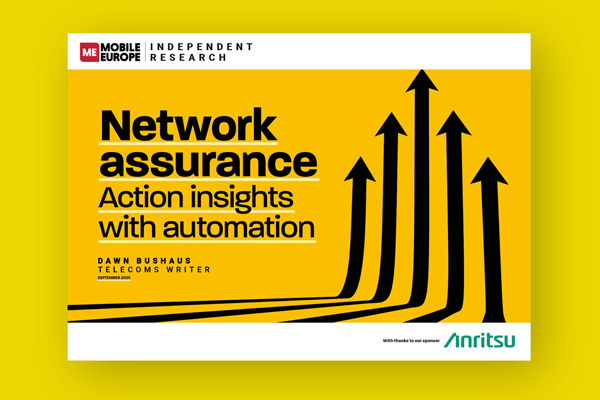Partner content: Operators collect ever more network data, but usable insights remain scarce; the next step is a practical software layer that turns raw signals into trustworthy actions
At our recent The Digital Telco opening panel on telecom innovation and growth, experts Malik Saadi (ABI Research), Colin Bannon (BT Business), Yue Wang (China Telecom) and Muhannad Alabweh (Infovista) argued that agentic AI (specialized AI agents able to fetch, validate and act on telemetry) gives operators an implementable path to scale automation without losing control.
Here’s why that matters, and what a pragmatic agentic AI approach in telecom looks like.
Why AI agents instead of bigger models
Telco networks are unusual data sources: heterogeneous, vendor-diverse and time-sensitive. Feed that into a large model without careful preprocessing and the output is noisy or irrelevant.
As Colin Bannon (CTO, BT Business) put it bluntly on the panel: “I would argue that we’re only using one percent of the data that we have on our network. The network, in fact, is the largest telemetry device that I know of in any company.”
Agentic AI in telecom addresses that gap by inserting purpose-built software units (agents) between raw telemetry and analytics. Rather than trying to force a single monolith to understand every nuance of telco signals, operators deploy various lightweight agents, each responsible for a narrow task.
That makes the whole system more robust, auditable and manageable.
The agentic layer splits into three functional roles:
1. A perception/retriever tier that ingests and normalizes telemetry with provenance;
2. Domain-specific validators and reasoning agents that check, enrich and score signals;
3. An orchestration/action tier that coordinates workflows and executes or recommends remediation (see infographic below).

Muhannad Alabweh (CPO, Infovista) illustrated the approach the company is embracing with its Agentic AI framework:
Infovista first “cleans the data, aggregates it, and makes sure it’s available as such,” then layers agentic capabilities so operators no longer wrestle with raw signal complexity.
He explained that specialized agents can, for example, extract quality-of-experience (QoE) insights for a given domain and present them in real time, with a telecom-tuned retrieval-augmented generation (RAG) layer grounding each response, allowing the platform to operationalize domain expertise at scale.
As he summarized: “We create specialized agents that go and deal with the network data itself.”
Why operators should favor Agentic AI patterns
Three practical benefits make this pattern attractive for carriers and large enterprises:
- Faster time-to-confidence. Small agents are simpler to test and reason about. You can validate a retriever or a validator in isolation and measure its effect on downstream models.
- Safer automation. With clear provenance and validator gates, confidence scores are meaningful. That enables human-in-the-loop thresholds: low-confidence cases go to an engineer, high-confidence cases trigger automated remediation.
- Incremental deployment. Operators don’t need to rip and replace. Agents can sit beside existing OSS/BSS stacks and progressively take over discrete tasks (site acceptance checks, KPI sanity runs, or anomaly triage) reducing operational risk.
Implementation guardrails
Embracing an Agentic AI framework is not a silver bullet; the panel highlighted practical guardrails operators must enforce:
- Provenance first. Every signal must carry collector ID, timestamp and version. Without that, debugging automation becomes an exercise in guesswork.
- Domain encoding. Agents need telecom-aware rules (RAN counters, sampling semantics), as generic data tooling alone won’t cut it.
- Auditable decisions. Every agent’s action must be logged with a human-readable rationale so auditors and engineers can replay decisions.
Infovista’s work in translating measurements into standardized, consumable data models shows how vendors can help operators implement these guardrails without rebuilding telemetry stacks from scratch. The right vendor approach balances domain expertise with open integration points so agents can be adopted incrementally.
A realistic roadmap for agentic AI pilots
Successful pilots prove a repeatable pattern, not a single miracle. The following three steps give a focused, measurable roadmap to test agentic automation and expand it safely:
1º Start small. Pick one high-value, repeatable task (for example, guided site acceptance or anomaly triage) and deploy a focused agent suite: retriever + validator + action.
2º Run the pilot across two sites to test repeatability, attach a simple human-in-the-loop threshold, and measure the change in mean time to detect and mean time to repair.
3º If the pilot shows consistent gains, expand the same pattern to similar tasks rather than chasing new, unrelated proofs.
Why it matters to operators now
Operator strategies increasingly turn on operational excellence, not just new radio features. Agentic AI is a practical, engineering-forward way to extract value from telemetry and to scale automation without sacrificing control. As the panel underscored, the problem is not a lack of data but the lack of intermediary logic that makes that data trustworthy and actionable.
For readers who want to explore the concept further, Infovista’s topic hub on Agentic AI in telecom provides a deeper look into how specialized agents are designed and deployed.




